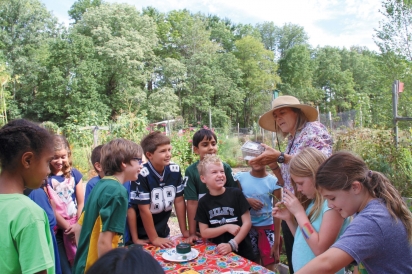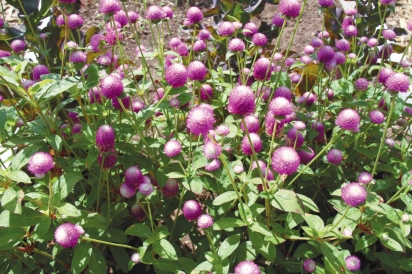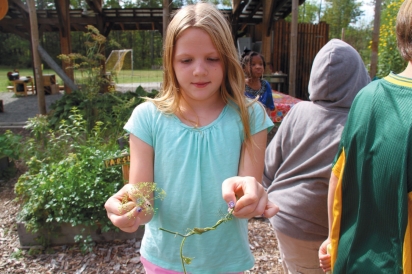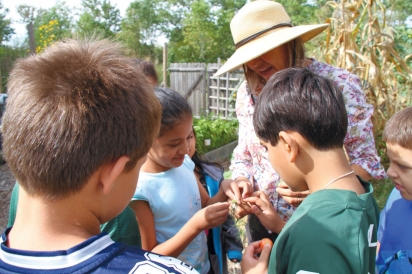How Does a Garden Grow at Princeton Day School?
Princeton Day School’s Pam Flory shares her green thumb with the next generation
You might say 2014 was a big year for the gardening program at Princeton Day School (PDS), and especially for Pam Flory, the garden coordinator. The school’s expansive garden, where Flory teaches students from pre-kindergarten through fourth grade, won the Edible Jersey School Garden Award, presented annually by this magazine and the New Jersey Farm to School Network. Flory herself was also presented with a national award: the Garden Club of America’s Elizabeth Abernathy Award, which recognizes outstanding achievement in early environmental education.
Flory, who lives in Hopewell and has a degree in economics from the University of Massachusetts, had never planned to be a teacher of any sort. Before having her children—Martin, thirteen, and Maddie, a fifth-grader at PDS—she was a commercial organic grower. After serving in the Peace Corps in the Kingdom of Tonga, she worked at North Slope Farm in Lambertville, where she met her husband, Rob Flory.
In 2000, she became the farm manager for Seward Johnson’s nascent organic farming project in Hopewell. She eventually founded her own business growing and selling organic flowers, and for a while was the gardening teacher at the Waldorf School of Princeton. “When I had my children, I decided to take a step back from commercial growing. But I kept my foot in with all the local growers and did a little consulting and part-time work.”
That all changed in 2008, when Flory was asked to be part of a summer gardening program at PDS. At the time, PDS had just established a school garden consisting of 22 plots, each three by twelve feet. The garden has since expanded: Currently it encompasses 8,500 square feet and includes a small flock of laying hens, three beehives and a beekeeper. “I jumped at the chance,” Flory says. “It was me and some other master gardeners. I did a two-week-long half-day program with the younger children. Having the commercial agricultural background was really helpful.”
When that program ended, Liz Cutler, the school’s sustainability coordinator, emailed all the instructors asking for feedback. “Liz had organized the program and was the driver behind the garden,” Flory explains. In fact, Cutler’s efforts in establishing the garden had won her the same Garden Club of America award a few years earlier.
The two women met at Small World Coffee in Princeton. “We chatted for over an hour,” Flory recalls. “Turned out I was the only one who responded” to her email. Flory recommended that Cutler hire a garden manager. “The reality is, there aren’t many teachers who have the confidence to teach a class out in the garden. And you have to have a plan for the garden itself.”
Soon after the coffee meeting, Flory was offered a part-time staff position managing the school garden. “I was getting paid for 12 hours a week, but I can’t even remember how many hours I was actually working,” she says. At the time, it was up to individual teachers in the first through fourth grades to decide whether their classes participated. “I immediately had six classes coming out, plus one or two kindergarten classes every now and again,” Flory says. “But by the end of the second year, all the teachers were asking for time in the garden. So the third year, we just put it into the schedule.”
Since 2011, Flory has been a full-time, salaried faculty member, as garden coordinator and educator. “That third year was when the school really committed to the gardening program. And, I must say, that commitment is the reason it works.” Flory also cites the initial and ongoing participation of parents and the larger PDS community as another factor in the program’s continuing success.
“When they first built the garden, it was really a community effort,” she says. “Liz understands that if the community is a part of it, they’re more invested in it and they’re going to want to take care of it. For the initial garden build, when they cleared the land and made all the beds, something like 150 community members came out.” During the PDS school year, Flory teaches sixteen classes a week.
“We just did a great class with the fifth graders, who are studying evolution. We investigated the brassica family by looking at a wild mustard plant and talked about how from that came broccoli, caulifl ower and kale. We did this exercise where they had to imagine a farmer artifi cially selecting for different traits of these plants to get to what we have today.”
Flory also directs three school garden clubs, including the middleschool food and garden club, which meets every other week during the school year. During the growing season, members of this club regularly cook and serve lunches for a group of students and teachers. Developing classroom curricula for all those levels is a challenge, Flory admits. In the beginning, she carefully observed how the classroom teachers, who stay with their charges during gardening, interacted with their students. “It still takes a lot of planning with the teachers, hearing what their classes will be studying and learning to make connections where we can,” she says.
Although the curriculum continues to evolve, one constant has been that each of the lower grades get a dedicated plant family. “Pre-K and kindergarten get the goosefoot family, which includes spinach,” Flory begins. “We grow lots of spinach and it’s so sweet in March— it’s one of the first things we eat together and everyone loves it. It’s so rewarding when you have to say to kids, ‘No more spinach! You can only have fi ve leaves.’ Or when parents come and say, ‘Where can I get the spinach that you grow in the garden? My children have fallen in love with it.’”
First graders are assigned the nightshade family, second graders the legumes, third graders the cucurbits (gourds), and fourth grade covers the brassicas. “When the students show up each fall, we do lots of harvesting of all those families,” Flory says. “Then, in the wintertime, we bring in the cooking component. We do a bit of cooking in the fall and spring, but the winter really lends itself to cooking, eating, and learning about the nutritional components of these particular plant families.”
The curriculum also has fourth-graders working with bees, including gathering honey under the direction of lower school science teacher Aaron Schomburg. Students also get lessons in fermentation. “A couple of years ago, we had Fermentation on Wheels come to the school,” Flory says of the Oregon-based roving educational project founded by Tara Whitsett in 2013. “She parked her bus right out in the garden and stayed with us for a week.”
PDS is also a participant in Garden State on Your Plate, the farm-toschool educational program founded by the Princeton School Gardens Cooperative under the direction of Dorothy Mullen and Diane Landis. The program includes having restaurant chefs cook with students at Princeton’s public elementary schools. “PDS was their first pilot school outside of the public schools,” Flory says. “Of course, we do it in our own PDS way. Since we were highlighting the brassicas this year, I said, ‘We have to make sauerkraut.’ The fourth-graders made sauerkraut.”
Flory recognizes how fortunate Princeton Day School is to have access to such resources, and feels an obligation to make the best use of them. With the administration’s approval, she has plans to expand the school’s composting program. “We’ve always composted, but now we’re trying to manage the pile a little more intensively so that we can compost [more]. Our aim is to keep all cafeteria food out of the landfill.” The garden, Flory says, is a cornerstone of the school’s sustainability program.
Among her job’s greatest rewards, Pam Flory says, is watching her students develop not only their palates but their willingness to try new things. “One of the teachers whose son is in this class told me he never eats mashed potatoes at home and predicted he wouldn’t try them. I said, ‘He’s going to surprise you’—and, sure enough, he ate the potatoes from the garden.” Flory says it is not unusual for fifthgraders, who have cycled out of the regular gardening program, to stop by the garden to say how much they miss it.
“My main job is to make kids fall in love with nature, with being outside,” says Flory, who is 51. “They’re going to be the ones to save nature.” Flory spoke of one child who came as a kindergartner and is now in fourth grade. “When he first came, he would not leave my side because he was terrified of insects. Now, he’s the kid who’s digging the deepest to find worms, or who picks up the garden centipede. And it’s just those moments when you think: Without this program, that would never have happened. Think of the things this boy would never have seen, never have noticed, never have eaten.”
Visit PDS’s student-run Seed Store and Seedling Sale this spring.
Seed Store—March 6–10; Seedling Sale—May 1–5
Princeton Day School
650 The Great Road, Princeton
609.924.6700
PAM FLORY’S TOP GARDEN TIPS
- Location, location, location. Your garden will do best with at least six hours of direct sunlight. You are also more likely to care for and harvest from your garden if it is close to your house, and ideally your kitchen.
- Maintain healthy soil. I cannot stress enough the importance of healthy soil for healthy plants. Healthy plants are more resistant to pests, diseases and dry conditions. Good compost goes a long way to improving soil.
- Have an easily accessible water source. A dry garden can lead to stressed and unhealthy plants and result in pest and disease problems.
- Fence your garden. Deer and groundhogs are a fact of life if you decide to garden in the Garden State. You will need to consider the height of your fence and possibly burying fencing to prevent digging and burrowing animals. Raccoons and squirrels are harder to keep at bay; you may need additional protection around their favorite plants if they find your vegetable garden.
- Make a plan: seedlings or seeds? Some plants do better when seeded directly; others thrive when transplanted as seedlings. Do some research before planting.
- Use high-quality planting material. Starting with high-quality seeds and seedlings will make a big difference in the health of the adult plants. Look for healthy color and robust stems, and try to avoid seedlings that are budding or fruiting. This could mean a stressed-out seedling.
- Grow what you like to eat. This may sound obvious, but for years I filled my garden with vegetables most of my family didn’t really like. With limited space, I now do successive plantings of greens and beans and grow the staples we actually use. For us that includes spring peas, tomatoes, potatoes, cucumbers and herbs.
- Protect your garden soil in the winter months. You can do this by planting winter wheat or rye as a cover crop or by covering the soil with leaf mulch, wood chips or cardboard.
- Rotate where your vegetables are planted each year (if you have the space). This helps with disease and pest control. There are many resources that can guide you with a rotation plan.










